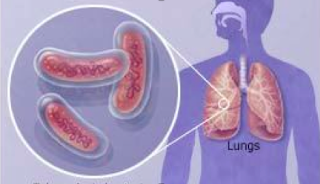Tuberculosis
TB is an airborne disease which usually affects the lungs and is caused by either of two bacterium:
Ø Mycobacterium Tuberculosis(M.tuberculosis)
Ø Mycobacterium Bovis (M.Bovis)
M.Tuberculosis
Mycobacterium Bovis(Bovine TB)
About one third of the world’s population has latentTB.
This means people have been infected by TB bacteria but are not yet ill with the disease and therefore cannot transmit the disease. However, they can become ill later on but it depends on their immune system.
Transmission Of Tuberculosis
u M.tuberculosis is carried in airborne particles called droplet nuclei.
u Infectious droplet nuclei is generated when persons who have active pulmonary or laryngeal TB cough, sneeze, shout or sing.
u If another person breathes in these germs, there’s a chance they will become infected.
u If this happens then the bacteria can settle in the lungs and begin to grow. From there, they move through the blood to other parts of the body.
Symptoms Of Tuberculosis
• Severe coughing that lasts three weeks or more
• Coughing up blood
• Chest pains or pains when breathing or coughing
• Fatigue
• Unintentional weight loss
• Fever
• Night Sweats
• Chill
• Loss of appetite
Treatment For Tuberculosis
- Medications are the cornerstone of tuberculosis treatment. But treating TB takes much longer than treating other types of bacterial infections.
- With tuberculosis, you must take antibiotics for at least six to nine months. The exact drugs and length of treatment depend on your age, overall health, possible drug resistance, the form of TB (latent or active) and the infection's location in the body.

After a few weeks, you won't be contagious and you may start to feel better. It might be tempting to stop taking your TB drugs. But it is crucial that you finish the full course of therapy and take the medications exactly as prescribed by your doctor. Stopping treatment too soon or skipping doses can allow the bacteria that are still alive to become resistant to those drugs, leading to TB that is much more dangerous and difficult to treat.
Some common TB drugs are:
- Isoniazid
- Rifampin
- Ethambutol
- Pyrazinamide
Drug-Resistant TB
 The bacteria that cause tuberculosis(TB) can develop resistance to the antimicrobial drugs used to cure the disease. There are two common types:
The bacteria that cause tuberculosis(TB) can develop resistance to the antimicrobial drugs used to cure the disease. There are two common types:
• MDR (multi drug resistant) TB is the name given to TB when the bacteria that are causing it are resistant to at least isoniazid and rifampicin, two of the most effective TB drugs
• Extensively drug-resistant TB (XDR TB) is a rare type of MDR TB that is resistant to isoniazid and rifampin, plus any fluoroquinolone and at least one of three injectable second-line drugs
This occurs when the drugs used to treat TB are misused or mismanaged by:
• Not completing the full course of TB treating
• Health care providers prescribing the wrong treatment (the wrong dose or length of time)
• Drugs being of poor quality
Drug Resistant TB is most common in people who:
• Do not take their TB drugs regularly
• Do not take all of their TB drugs
• Come from areas of the world where drug-resistant TB is common
• Have spent time with someone known to have drug-resistant TB disease
Prevention Of TB
As with all health conditions, prevention of TB is always better than a cure. Although there is no sure-fire way to completely prevent the spread of TB at this point in time, there are a number of measures that can be put in place to reduce the spread of the illness, such as:
- The BCG Vaccination
- TB Treatment as TB Prevention
- Isolation
The BCG Vaccination
Bacille Calmette-Guérin (BCG) is a live strain of Mycobacterium bovis developed by Calmette and Guérin for use as an attenuated vaccine to prevent tuberculosis and other mycobacterial infections. The vaccine was first administered to humans in 1921 and remains the only vaccine against tuberculosis in general use.
TB Treatment as TB prevention
TB drug treatment for the prevention of TB, also known as chemoprophylaxis, can reduce the risk of a first episode of active TB occurring in people with latent TB.
Isolation
Since TB is transmitted from person to person through the air, one way of preventing it is through
Home Isolation
Home isolation is when people with TB disease are required to stay home and limit their activities outside the home in order to prevent spreading TB to others. You will need to stay on home isolation until the TB doctor tells you that you are no longer at risk of spreading TB to others.














No comments:
Post a Comment